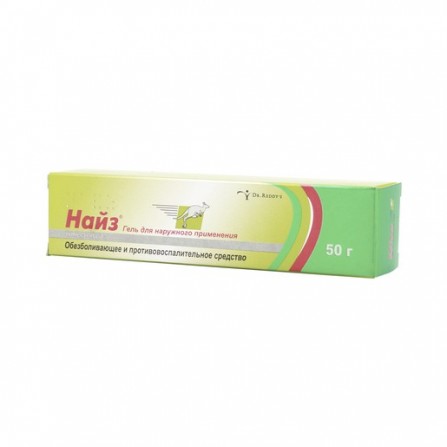More info
Active ingredients
Nimesulide
Release form
Gel
Composition
1 g of gel contains: active ingredient: nimesulide 10 mg; excipients: N-methyl-2-pyrrolidone 250 mg, propylene glycol 100 mg, macrogol 315.5 mg, isopropanol 100 mg, purified water 200 mg, carbomer-940 20 mg, butyl hydroxyanisole 0.2 mg, thiomersal 0.1 mg, potassium dihydrophosphate 0.2 mg, flavoring (Narcissus-938) 4 mg.
Pharmacological effect
Nise Gel is a non-steroidal anti-inflammatory drug (NSAID) of the new generation from the sulfonamide class. It has a local anesthetic and anti-inflammatory effect. Nimesulide is a selective competitive reversible inhibitor of cyclooxygenase type II (endoperoxide-prostaglandin-H2 synthetase). Reduces the concentration of short-lived prostaglandin H2, a substrate for kinin-stimulated prostaglandin E2 synthesis, in the focus of inflammation and in the ascending pathways of pain impulses in the spinal cord. The decrease in the concentration of prostaglandin E2 (a mediator of inflammation and pain) reduces the activation of EP-type prostanoid receptors, which is manifested by analgesic and anti-inflammatory effects. When applied topically, it causes weakening or disappearance of pain at the site of gel application, including pain in the joints at rest and during movement, and reduces morning stiffness and swelling of the joints. Contributes to increased range of motion.
Pharmacokinetics
When applying the gel, the concentration of the active substance in the systemic circulation is extremely low. The maximum concentration after a single application is noted by the end of the first day, its value is more than 300 times lower than that for oral dosage forms of nimesulide. Traces of the main metabolite of nimesulide, 4-hydroxynemesulide, are not detected in the blood.
Indications
Local symptomatic treatment of inflammatory and degenerative diseases of the musculoskeletal system (joint syndrome in exacerbation of gout, rheumatoid arthritis, psoriatic arthritis, ankylosing spondylitis, osteoarthritis, osteochondrosis with radicular syndrome, sciatica, inflammation of ligaments, tendons, bursitis, sciatica, lumbago). Muscle aches of rheumatic and non-rheumatic origin. Post-traumatic inflammation of the soft tissues and the musculoskeletal system (damage and rupture of ligaments, bruises).
Contraindications
Hypersensitivity to nimesulide and components of the drug; Erosive and ulcerative lesions of the gastrointestinal tract in the acute stage, bleeding from the gastrointestinal tract, dermatosis, damage to the epidermis and infection of the skin in the application area; severe renal (creatinine clearance less than 30 ml / min) or liver failure, a history of bronchospasm associated with the use of acetylsalicylic acid or other NSAIDs, pregnancy and lactation, children up to 7 years.
Use during pregnancy and lactation
Contraindicated
Dosage and administration
Outwardly. Wash and dry the skin before applying the gel. Apply a gel column of about 3 cm in length to the area of maximum pain without a uniform thin layer, 3-4 times a day, without rubbing. The amount of gel and the frequency of its use (no more than 4 times per day) can vary depending on the size of the treated area and the patient's response. Do not use the gel for more than 10 days without consulting a doctor.
Side effects
Local reactions: itching, urticaria, peeling, transient discoloration of the skin (not requiring discontinuation of the drug). If any adverse reactions occur, discontinue use of the drug and consult a doctor. When applying the gel to large areas of skin or with prolonged use, the development of systemic adverse reactions is not excluded: heartburn, nausea, vomiting, diarrhea, gastralgia, ulceration of the gastrointestinal mucosa, increased activity of liver transaminases; headache, dizziness; fluid retention, hematuria; allergic reactions (anaphylactic shock, skin rash); thrombocytopenia, leukopenia, anemia, agranulocytosis, prolongation of bleeding time.
Overdose
Cases of drug overdose are not described. However, when applying large amounts of gel (exceeding 50 g) over large areas of skin, an overdose may occur. There is no specific antidote. It is necessary to consult a doctor.
Interaction with other drugs
It is not excluded pharmacokinetic interaction with drugs that compete for communication with plasma proteins. Care should be taken when using Nise with digoxin, phenytoin, lithium preparations, diuretics, cyclosporine, methotrexate, other NSAIDs, antihypertensive and antidiabetic agents.Before using the gel, you should consult with your doctor if you use these funds or are under the supervision of a doctor.
special instructions
The drug is recommended to be applied only to intact skin, avoiding contact with open wounds. Avoid getting the gel in the eyes and other mucous membranes. Do not use the gel under air-tight dressings. After applying the gel, wash your hands with soap and water. Close the tube tightly after using the gel.





